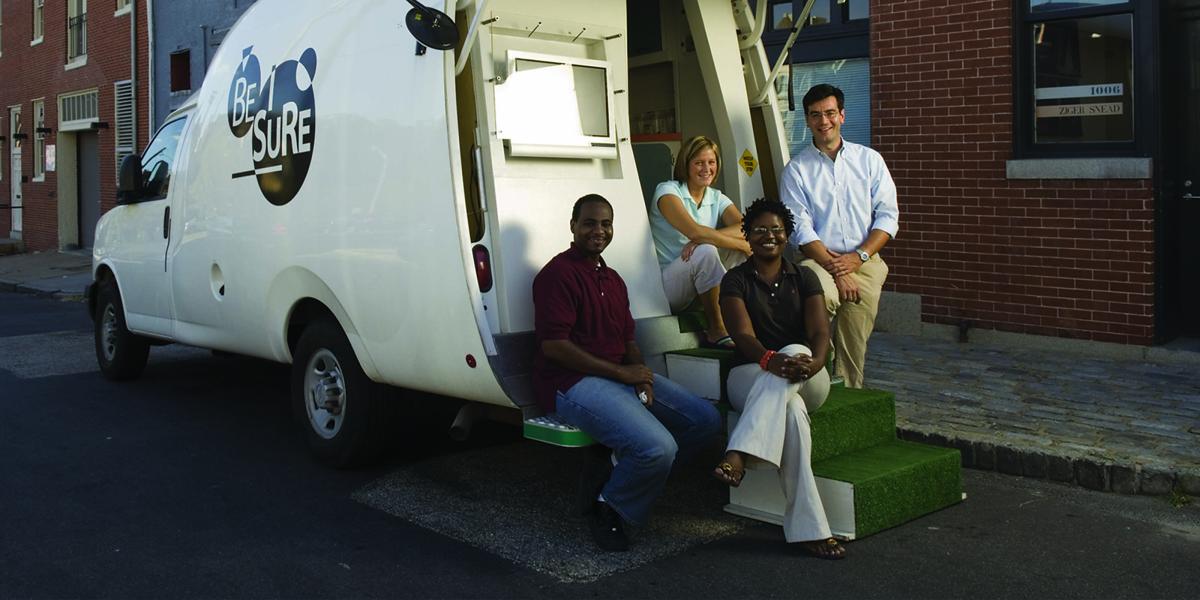Stepping Up Surveillance to Fight AIDS
Though McCay Moiforay has told dozens of men that they are HIV positive, delivering such news "never gets easier."
"It's a devastating thing to have to tell someone, and you're always mindful of the impact of what you are about to say will have on the human being sitting there in front of you," says Moiforay. "It's hard to describe just how difficult that is."
Moiforay conveys test results as part of his work with the Behavioral Surveillance Research Study, or BESURE. Conducted in Baltimore by the Bloomberg School in collaboration with the Maryland AIDS Administration and funded by the Centers for Disease Control with the AIDS Administration, BESURE is a multiyear, 25-city, community-based study designed to look at HIV risk behaviors and their prevalence over time in three marginalized populations: men who have sex with men (MSM); injection drug users (IDU); and heterosexual men and women impacted by poverty and living in areas with high HIV/AIDS prevalence.
Baltimore's BESURE team began recruiting men who have sex with men for the study back in 2004 and concluded that cycle in the spring of 2005 after interviewing nearly 1,000 men. They recently finished the IDU portion (which included meetings with 680 injection drug users) and currently are poised to begin recruiting heterosexuals this fall. By the end of that cycle, the team hopes to have gathered data on at least 750 men and women.
Frangiscos Sifakis, principal investigator for Baltimore BESURE and an Epidemiology faculty assistant scientist, says that his team and those conducting the study in other cities are hopeful that their findings will eventually translate into strategic prevention programs.
"We are scientists, and not policymakers, but it would be disingenuous to say that we don't hope that getting a firm grasp on what behaviors put people at risk will eventually drive public policy," says Sifakis, PhD '02, MPH.
Soft-spoken and intense, Sifakis heads up a four-member BESURE "crew": interviewers Moiforay and Keba Robinson, study coordinator Carol Hilton and field data manager Martha Hilton. The crew interviews study subjects about behaviors that put them at risk, takes blood samples for HIV testing and tells people their HIV-status, among other duties. (HIV testing was offered only in Baltimore and five other BESURE study sites during the MSM phase.)
The team works out of a brightly renovated row house office in Baltimore's Mount Vernon neighborhood, where study subjects not only can be interviewed in private but also can watch health-promoting videotapes, use a telephone to call family and friends, and spend time on the office's Internet-connected computer, looking for employment and health care information.
Though the study is far from complete, Baltimore's BESURE made the news last summer when the state Department of Health and Mental Hygiene announced that a little more than one-third of the MSM study participants tested positive for HIV, and almost half of the study's African-American participants tested positive. As a result, the department established a Rapid Response Team that linked agencies and leaders from the HIV prevention and treatment community to the at-risk population.
"What we have learned so far speaks to just how powerful true community-based research is in giving those of us concerned with public health a clear picture of the extent of this epidemic and a glimpse into how prevention can best be approached," says Sifakis.
"I think one factor that is also helpful is that most people in Baltimore know someone—a friend or relative or co-worker—who has been touched in some way by HIV," says Moiforay. "They know it's a problem and that we are trying to be part of the solution in the long run."
From a national perspective, the study will allow the CDC to refine its measures of HIV-risk behavior and its prevalence. These new and more accurate estimates allow for policy and prevention funding planning that Sifakis says is "more reflective" of reality and is also sensitive to the changing reality of the HIV epidemic in the U.S.
On the local level, the new estimates will permit health departments to better understand the subgroups of people most at risk, and to observe changes in these groups or their behaviors over time, which Sifakis claims will help in targeting local HIV prevention and education programs.
"The success of this effort really depends on its flexibility," he says. "This is an ever-changing epidemic propagated by ever-changing behaviors, ascribed to by an ever-changing group of individuals."
